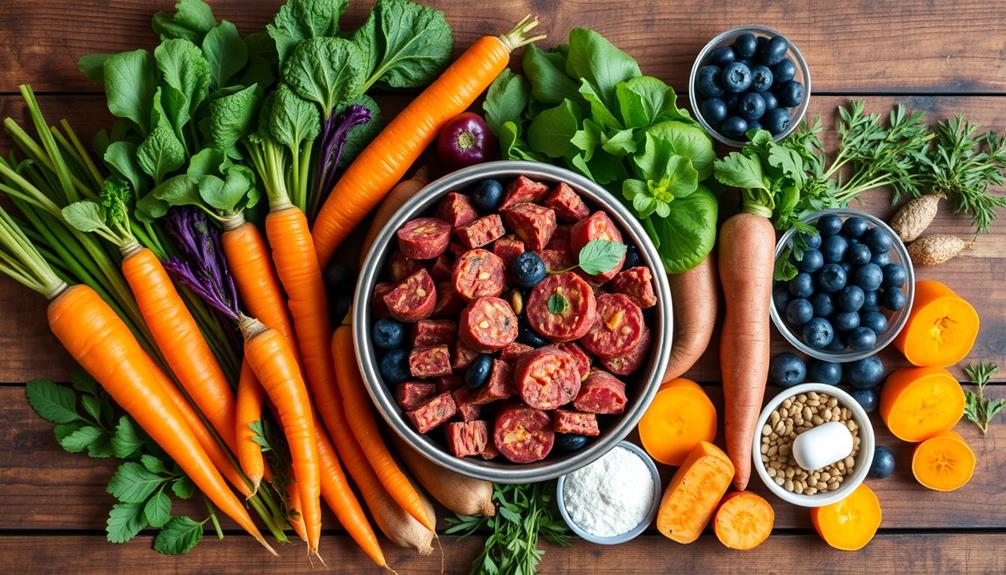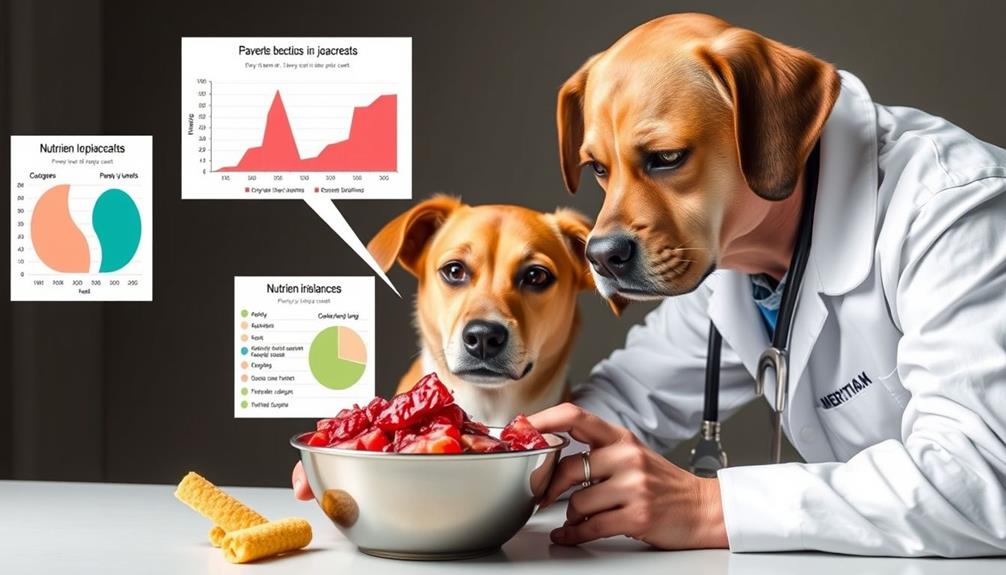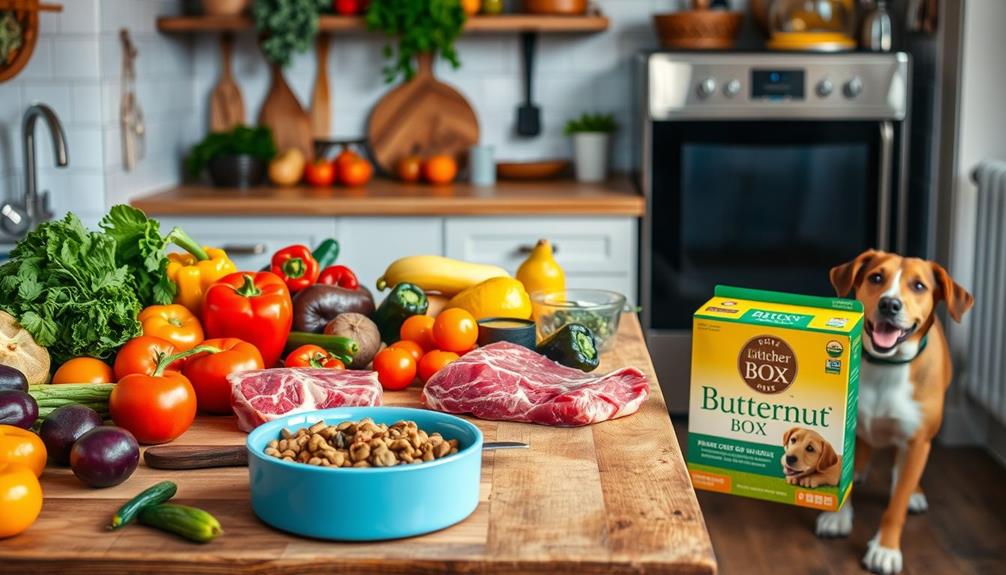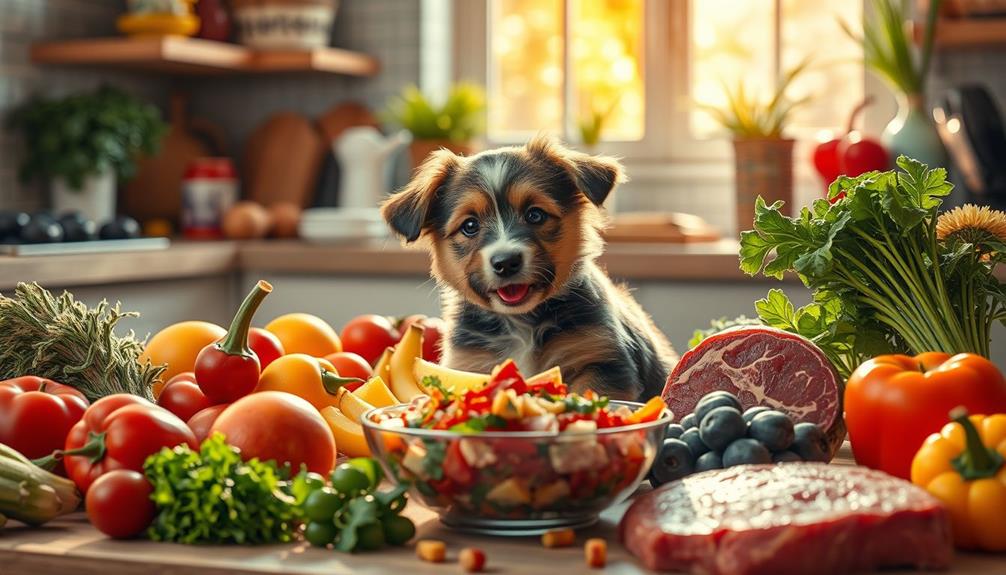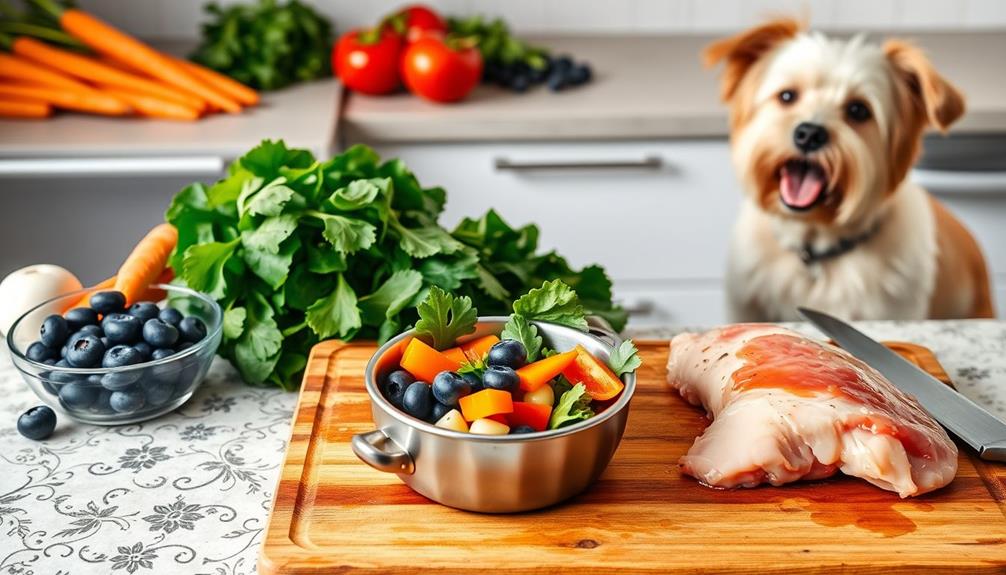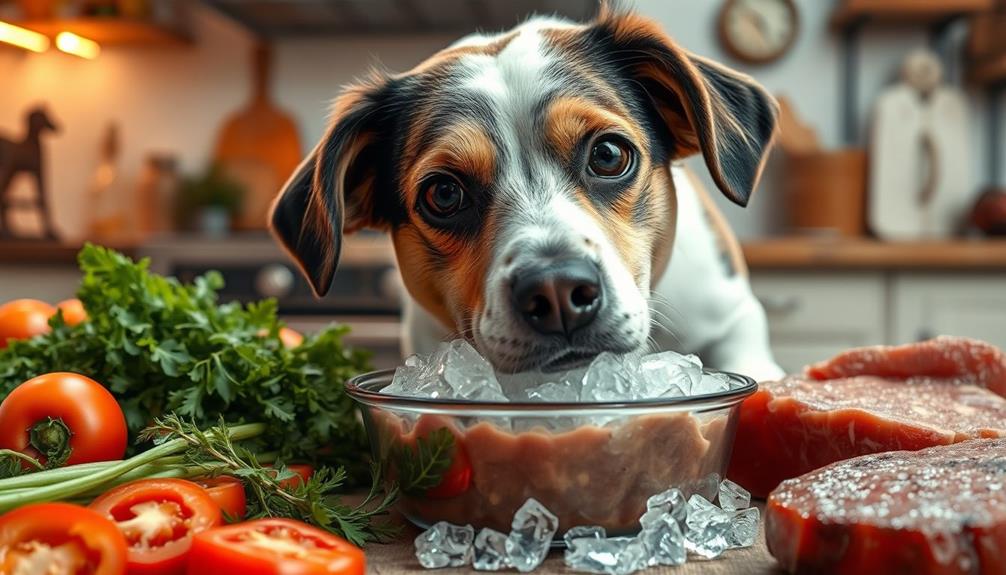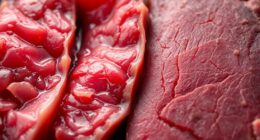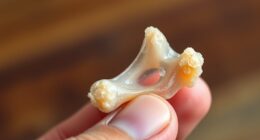You can easily enhance your dog's raw food diet by adding fresh ingredients. Consider incorporating raw eggs for essential fatty acids and organ meats like beef liver for quality protein. Canned pumpkin aids digestion and provides fiber, while fruits like blueberries and apples (without seeds) offer natural sweetness and vitamins. Probiotics from kefir can improve gut health, and healthy fats like coconut oil can enhance hydration and skin health. Just remember to introduce new additions gradually to monitor reactions. Explore more ideas and tips on how to keep your dog's meals nutritious and delicious.
Key Takeaways
- Add fresh foods like bananas, apples (without seeds), and blueberries in moderation to enhance your dog's diet with vitamins and antioxidants.
- Incorporate high-quality protein sources such as raw eggs and organ meats to provide essential amino acids and omega-3 fatty acids.
- Mix in probiotic-rich options like kefir and low-sodium sauerkraut to support digestion and improve nutrient absorption.
- Include healthy fats like coconut oil and bone broth to promote skin health and hydration.
- Ensure fresh foods comprise no more than 20% of total daily caloric intake to maintain a balanced diet.
Nutritional Additions for Dogs
When enhancing your dog's raw food diet, consider incorporating a variety of nutritional additions that can greatly boost its overall value. Adding fresh foods can provide essential nutrients, but remember to keep these additions to no more than 20% of your dog's total daily caloric intake to maintain balance.
For a tasty and nutritious option, you might want to try including some healthy dog snacks that can complement the raw diet while also keeping your dog engaged and satisfied.
Nutritional additions like raw eggs are fantastic sources of biotin and omega-3 fatty acids, which are important for skin health. Organ meats, such as beef liver, offer quality amino acids and essential nutrients that support overall health.
You might also want to include omega-3-rich foods like canned sardines or mackerel; these not only help reduce inflammation but also contribute to a healthy gut.
Probiotic sources like kefir or low-sodium sauerkraut can improve digestion and nutrient absorption, tackling any digestive issues your dog might face.
Additionally, ensuring a proper calcium-phosphorus ratio is important when incorporating these additions. By thoughtfully selecting these nutritional enhancements, you can create a more balanced and enriching raw food diet that supports your dog's health and well-being.
Safe Fruits and Vegetables
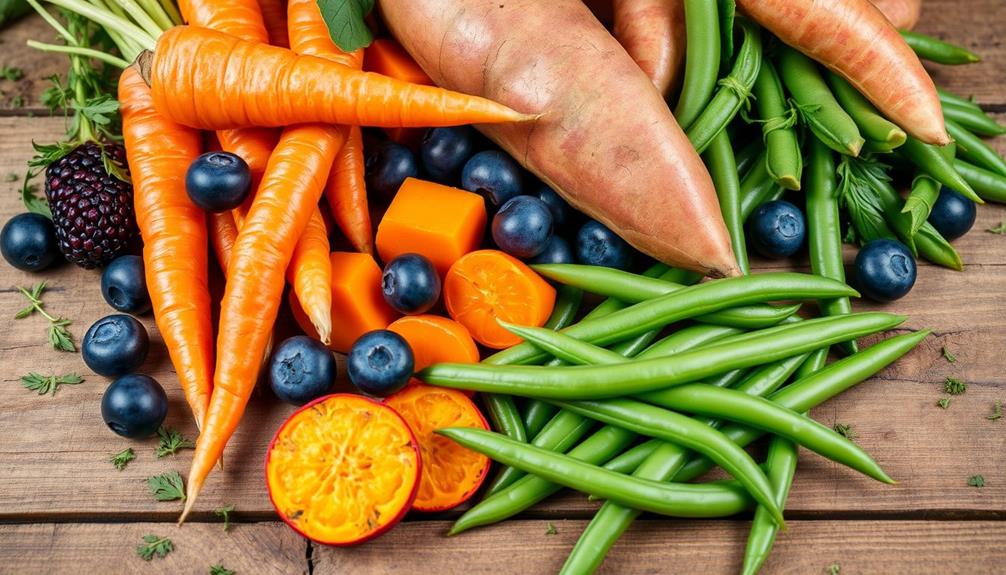
Incorporating safe fruits and vegetables into your dog's raw food diet can enhance their nutrition and add variety. These additions provide essential vitamins and antioxidants while keeping sugar content low. For example, bananas, apples (without seeds), melons, and blueberries are all safe fruits to offer your furry friend in moderation.
Vegetables like canned pumpkin (not pie filling) are a nutritious option that aids digestion and helps regulate stool consistency. You can also consider cooked or pureed vegetables to improve digestibility and nutrient absorption. However, be cautious and avoid feeding grapes, raisins, onions, and nightshade family plants, as they can be harmful.
When introducing new fruits and vegetables, remember to do so gradually to monitor reactions. This approach helps you identify any adverse effects on your dog's digestion.
| Safe Fruits | Safe Vegetables |
|---|---|
| Bananas | Canned Pumpkin |
| Blueberries | Cooked Carrots |
| Apples (no seeds) | Pureed Sweet Potatoes |
Guidelines for Fresh Foods
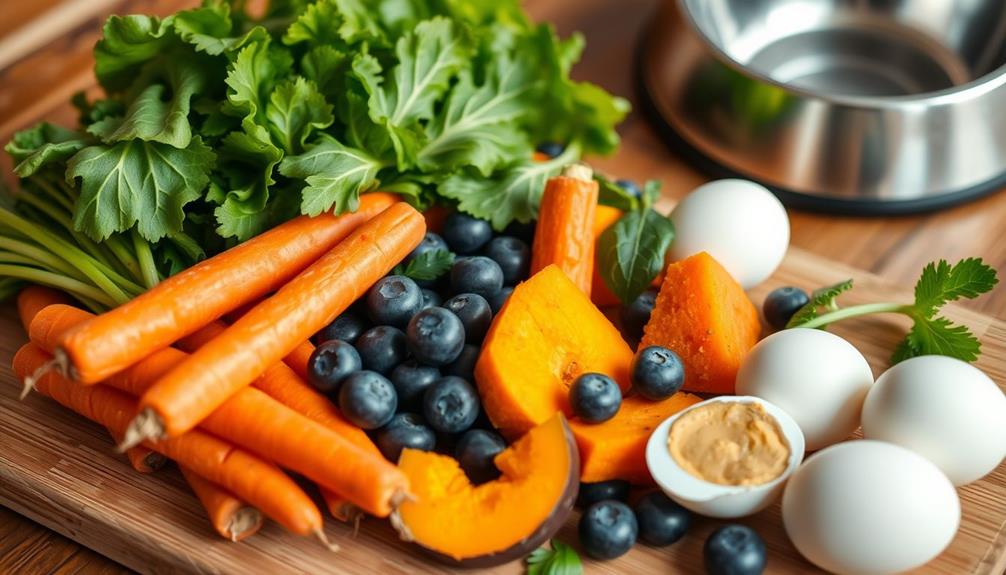
Adding fresh foods to your dog's diet can greatly enhance their overall health and well-being. To maintain a balanced diet, make certain that fresh foods make up no more than 20% of your dog's total daily caloric intake. This means you'll need to reduce the amount of processed food accordingly.
When introducing fresh foods, do it gradually to prevent digestive upset, and keep an eye on how your dog responds to these changes. Incorporating high-moisture ingredients like canned pumpkin or bone broth can boost your dog's hydration and improve nutrient absorption, much like how certain foods can help manage gout symptoms.
Establishing a weekly feeding schedule for fresh foods can help simplify meal prep and determine the right quantity needed for your dog.
Don't forget to offer a variety of protein sources, including lean meats and organ meats. This guarantees your dog gets a balanced intake of essential nutrients and amino acids, supporting their overall health.
Enhancing Nutritional Value
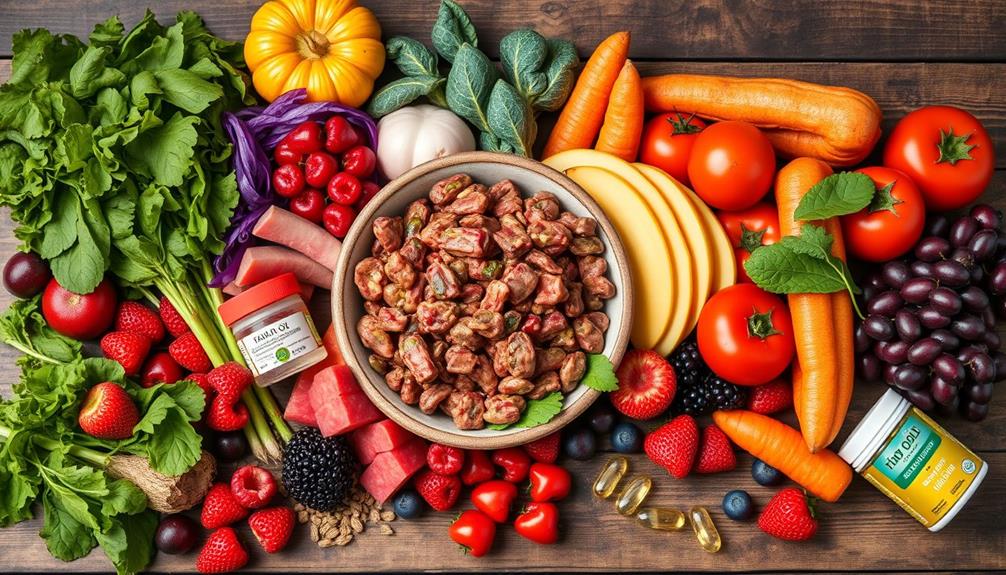
To enhance your dog's raw food diet, consider adding nutrient-rich options like organ meats and omega-3 sources.
These additions not only boost essential vitamins and minerals but also improve moisture and hydration in their meals.
Incorporating a variety of fresh ingredients can also contribute to your dog's overall wellness, similar to how a proper diet is essential for small pets like hamsters, as highlighted in the ultimate hamster care guide.
You'll see the benefits reflected in your dog's overall health and well-being.
Nutrient-Rich Additions
Boosting your dog's raw food diet with nutrient-rich additions can make a significant difference in their overall health and well-being. Start by incorporating fresh foods like eggs, muscle, and organ meats, which provide essential proteins, vitamins, and omega-3 fatty acids. These nutrients are crucial for your dog's energy and growth, and similar to Cranberry Juice Consumption, they can contribute to overall health benefits.
Don't forget about probiotic-rich foods such as kefir and fermented vegetables. They support gut health and improve digestion, contributing to your dog's overall wellness.
Nutrient-dense vegetables like canned pumpkin and cooked sweet potatoes add fiber and important vitamins, helping regulate digestion and stool consistency.
Healthy fats, including coconut oil and bone broth, not only enhance skin and coat health but also provide hydration thanks to their rich fatty acid content.
Moisture and Hydration Boosts
Incorporating moisture and hydration boosts into your dog's raw food diet not only enhances its nutritional value but also supports overall health. Keeping your pup well-hydrated is vital for digestion, skin health, and overall wellness.
Consider adding essential oils for dogs that may provide additional health benefits. Here are some effective additions you can make:
- Bone broth: This nutrient-rich liquid promotes hydration, aids digestion, and supports joint health. Aim for 1 tablespoon per 20 pounds of body weight.
- Coconut water: A natural hydration booster, it provides electrolytes without added sugars. Use it in moderation to enhance your dog's hydration.
- Plain filtered water: Mixing this directly into raw meals increases moisture content, ensuring your dog stays hydrated, especially if they eat dry kibble too.
- Canned pumpkin: Adding this ingredient can improve moisture levels and provide soluble fiber, helping with digestion and regulating stool consistency.
Additionally, consider incorporating omega-3 supplements or fish oil into their meals. These not only support hydration but also contribute essential fatty acids, promoting healthy skin and coat.
Implementation Strategies
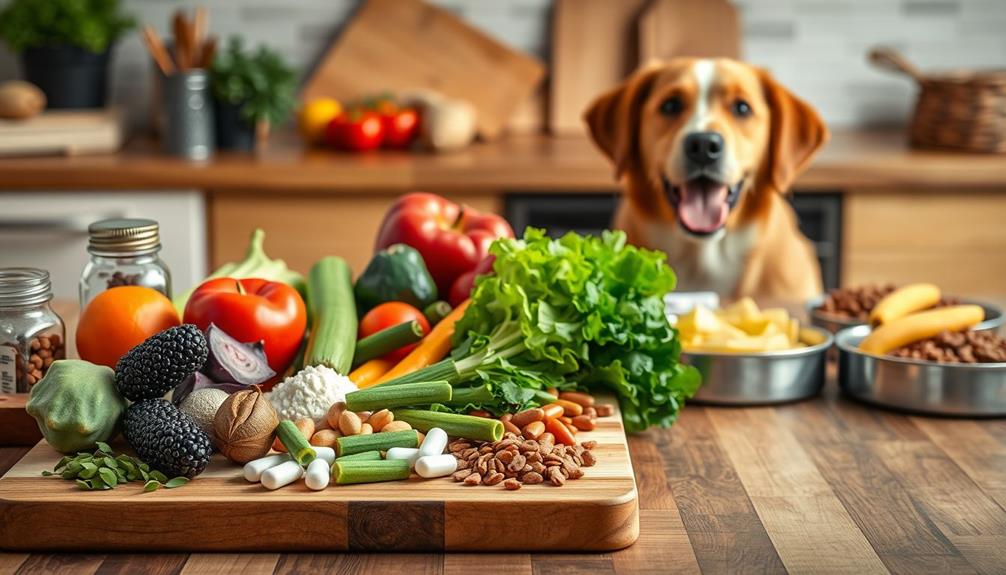
Introducing new enhancements to your dog's raw food requires a thoughtful approach to confirm a smooth change. Start by gradually introducing food additions, beginning with small amounts to monitor your dog's reactions. This mitigates the risk of digestive upset while allowing you to adjust as necessary.
Aim for a balanced raw diet by confirming that these additions don't exceed 20% of your dog's total caloric intake. Additionally, considering the importance of monitoring your dog's health and behavior can help you identify any changes that may need further attention, similar to how managing behavioral issues in seniors requires careful observation and adjustment.
Implement a weekly meal prep schedule to efficiently measure and prepare the appropriate quantities of moisture-rich ingredients, like bone broth or pureed vegetables. These not only enhance hydration but also support digestion and nutrient absorption, boosting your dog's health.
Keep track of the nutritional value and portion sizes of both raw foods and additions using a spreadsheet. This will help you maintain dietary balance and make easy adjustments.
Regularly rotating protein sources and fresh food additions ensures that your dog's diet remains diverse, preventing dietary imbalances. By following these implementation strategies, you'll effectively enhance your dog's diet, maximizing the health benefits while providing a varied and enjoyable eating experience.
Resources for Dog Care
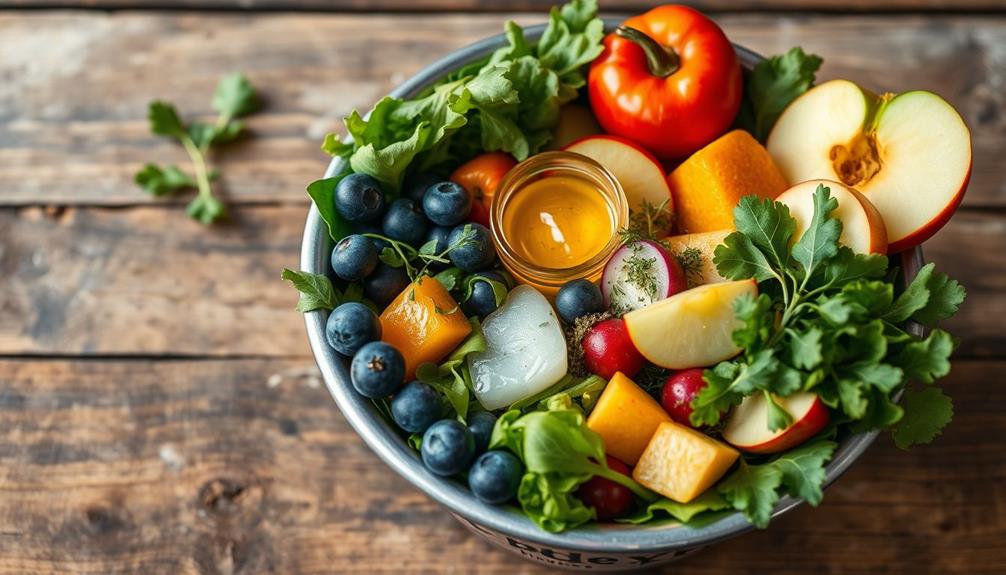
When enhancing your dog's diet, having reliable resources can make a significant difference in your approach. Understanding the importance of key domains of development in your dog's nutrition can help in addressing any potential health concerns.
By tapping into expert advice and actionable insights, you can effectively improve your dog's overall diet and health. Here are some invaluable resources to take into account:
- Unlocking the Canine Ancestral Diet: This guide helps you incorporate fresh ingredients into both commercial and raw dog food, ensuring you maximize nutritional benefits.
- See Spot Live Longer: Available in print and eBook, this resource emphasizes healthy feeding practices and reveals how fresh and nutritious food for your dog can boost their well-being.
- DogAware.com: A thorough website that covers various dietary approaches, helping you understand the impact of beneficial bacteria and the importance of avoiding highly processed foods.
- Whole Dog Journal: This publication offers expert advice on nutrition, training, and health tips, enabling you to make informed decisions about your dog's diet.
Frequently Asked Questions
What Can I Add to Raw Dog Food to Make It Complete?
To make raw dog food complete, add organ meats for vitamins, vegetables for fiber, omega-3 sources for skin health, probiotics for digestion, and calcium supplements for strong bones. Your dog'll thrive with these enhancements!
How Can I Make My Raw Dog Food Taste Better?
Want to spice things up like a chef in a fancy restaurant? You can enhance your dog's raw food by adding canned pumpkin, yogurt, raw eggs, bone broth, or pureed veggies for flavor and health benefits! Looking for more options to elevate your dog’s dining experience? Consider adding sardines, coconut oil, or turmeric to their meals for added nutritional value and taste. These puppy raw food options can provide essential nutrients and flavor variety to keep your pup’s meals exciting and delicious. Plus, they can help support their overall health and well-being.
What Should I Supplement With Raw Dog Food?
You can supplement raw dog food with fresh vegetables, probiotics, and animal-source foods. Adding omega-3s from fatty fish and bone broth enhances nutritional value, improving digestion, skin health, and overall well-being for your furry friend.
What Can I Do to Enhance My Dogs Food?
You know what they say: "You are what you eat." To enhance your dog's food, mix in fresh eggs, safe veggies, and probiotics. This'll boost nutrients, improve digestion, and keep your furry friend healthy and happy!
Conclusion
By adding the right enhancements to your dog's raw food, you can boost their health and happiness greatly. Did you know that incorporating just a few safe fruits and veggies can increase their vitamin intake by over 50%? It's a simple way to elevate their diet and keep them thriving. Remember, variety is key, so mix things up and watch your furry friend enjoy their meals even more! Happy feeding!

